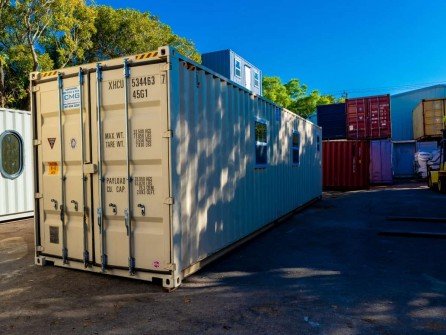An essential factor to consider before shipping is the weight of a dry shipping container. Before the shipping process can begin in most countries, an official weight for a container must be provided.
The weight of your shipment also influences how much fuel is required to transport it. The greater the weight of your shipment, the more fuel is required to transport it from point A to point B.
Depending on the type of container, an empty 20-ft shipping container weighs between 1.8-2.2 metric tons (about 3,970 - 4,850 lb), and an empty 40-ft shipping container weighs between 3.8 - 4.2 tons (8,340 - 9,260 lb).
High-cube containers, for example, are typically heavier. More height equates to more metal, which equates to more weight.
It is also important to note that a container's tare weight can vary depending on its shape and construction material. The tare weight varies according to the type of container and the items loaded onto it.
Tare Weight, Gross Weight, and Payload Weight
Tare weight is simply the weight of an empty container. Unladen weight is sometimes used instead of tare weight. Tare and unladen weight are synonymous and refer to the weight of a container when it is not loaded with cargo.
Typically, this measurement is taken with the container on a flat surface, such as a scale.
The payload weight is the most weight that can be safely added to an empty container. After the manufacturing process is completed, the tare weight of a shipping container is frequently welded on the container doors.
Finally, the total weight of the container and all of its cargo (including containers, packing, and pallets) is referred to as the gross weight. This is the standard weight used to calculate shipping costs.
It is common practice to subtract the tare weight from the gross weight when calculating the weight of goods. However, when calculating the weight of an entire container, this method can be inaccurate due to other variables such as fuel.
Shipping Container Sizes & Tare/Gross/Payload Weights
Before we get into the specifics of each container size, here's a table that shows the dry shipping container weight capacities for 20ft to 45ft containers:
| Container Size | Tare Weight (lbs) | Maximum Gross Weight (lbs) | Maximum Payload Weight (lbs) |
| 20 ft. | 5,071 | 55,126 | 50,055 |
| 40 ft. | 8,554 | 67,196 | 58,642 |
| 45 ft. | 10,362 | 71,650 | 61,288 |
20ft.: A 20-foot shipping container weighs 5,071 lbs when empty. Its maximum gross weight is 55,126 pounds. Because of its middle-of-the-road size, it has become one of the most popular for goods shipment.
40ft.: The 40ft shipping container, like the 20ft containers, is a popular choice for shipments, job site offices, and onsite storage. It has a tare weight of 8,554 pounds, a maximum gross weight of 67,196 pounds, and a payload weight of 58,642 pounds.
45ft.: Due to its 9ft 6in exterior height, a 45ft container is regarded as a high cube container. Its maximum gross weight is 71,650 lbs. Its tare weight is 10,362 lbs.
They are intended for intermodal freight transportation of general freight that is lighter in weight. Due to their maximum cubic capacity, they are the perfect option for industrial, commercial, and rural storage applications.
What are the Factors that Affect the Shipping Container Weight?
Cube Height: The first factor that we should mention is cube height. High cube containers (9ft 6 in) are one inch taller than standard height containers (8ft 6 in). This means they contain more metal and are heavier than standard shipping containers.
Double Doors: A standard shipping container only has doors on one end, whereas a double-door container has doors on both ends. Because more doors on a shipping container require more metal, double-door containers are heavier.
Manufacturing Period: Older shipping containers are often heavier than newer, more modern ones. This is because modern manufacturing techniques have enabled the construction of containers with significant strength using less metal.
Why is the Weight of a Shipping Container an Important Matter?
Knowing the weight of a container is critical since overloaded or unbalanced shipping containers are a recipe for disaster, putting both container ships and shippers at risk.
Due to this, the IMO (International Maritime Organization) in 2016 mandated that shippers provide a Verified Gross Mass (VGM) before their cargo could be loaded onto a ship for export.
This rule was implemented in response to the accidents that kept happening as a result of overweight containers.
To avoid fines and penalties, all shipping companies are required to comply with the SOLAS VGM requirements - Safety Of Life At Sea, as well. This means that they must accurately weigh their shipping containers and optimize loads.
What is More to Know?
- How to weigh loaded containers?
There are several widely used techniques for container weighing. Some of the ways are:
- Weighing on the ground,
- Weighing on a truck (on a chassis),
- Driving a truck loaded with a container over truck scales.
- How Much Does a 20’ Shipping Container Weigh
When discussing the weight of a container, there are three different types to consider. The empty shipping container weight is its tare weight. The total weight that can be loaded into a container is called the payload weight. The payload capacity plus the tare weight add up to the gross weight.
The tare weight of a 20 ft. container is approximately 4,914 lbs, while its maximum payload capacity is 47,900 lbs, and its gross weight is 52,813 lbs. Because it's lightweight, the 20-foot shipping container is a popular choice. It's ideal for carrying little loads of dry goods, such as grains, electronics, and clothes.
- How Much Does a 40’ Shipping Container Weigh
The tare weight of a 40 ft. standard shipping container is roughly 8,159 lbs, and its maximum payload capacity is approximately 59,039 lbs. At full load, it can weigh up to 67,199 lbs. The tare weight of a 40 ft. high cube container is roughly 8,747 lbs, and its maximum payload capacity is approximately 58,448 lbs. A maximum of 67,196 lbs is possible when loaded.
A 40 ft. standard container and a high cube container differ primarily in height. A 40 ft. standard shipping container has an external height of 8.5 feet. However, the external height of a 40 ft. high cube container is 9.5 feet.
- What is Considered Overweight for a 40' Container
The International Organization for Standardization (ISO) states that a typical loaded 40 ft container can only weigh a maximum of 67,200 lbs. A container may be deemed overweight in any one of the three following scenarios.
Gross weight: The combined weight of the tractor, chassis, container, and cargo cannot be greater than the gross weight of the truck and its cargo. Axle Weight: This refers to the maximum gross weight that a truck's single axle or set of axles may have. Federal Bridge Formula (FBF): The US FBF is used to determine the maximum weight that can be supported based on the separation between axle sets.
One way to find out if you comply with government transport regulations is to weigh containers to optimize the payload based on their dimensions. Before a container is loaded onto a ship for export, the International Maritime Organization (IMO) mandates that shippers provide a Verified Gross Mass (VGM) of the container. This will reduce the number of accidents brought on by overweight containers.
To avoid penalties, shipping companies must adhere to the Safety of Life at Sea (SOLAS) VGM regulations, which require them to accurately weigh the shipping containers and optimize the loads.















